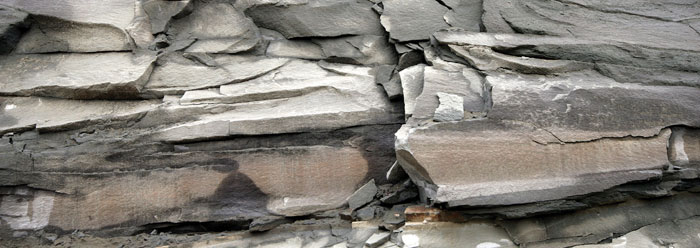The National Creation Science Foundation (NCSF) has received several fine proposals for NCSF grant-supported research, and many of these proposals have already been funded. One such proposal was submitted by Cornelius Van Wingerden and Roger Sigler, both graduates in geology from the ICR Graduate School. They seek to find a proper interpretation for the appearance of the Kingston Peak Formation in the Mojave Desert, one which incorporates the Genesis Flood in its model. This project comes under the Flood-Activated Sedimentation and Tectonics (FAST) project, directed by Dr. Steve Austin.
Enormous deposits of boulder breccias, mega-breccias, diamictites, pudding-stones, and associated slide blocks and gravity flows of Upper Proterozoic strata have been correlated worldwide. The Kingston Peak Formation (KP) is one of these formations, which occur in several mountain ranges of the Mojave Desert. The Great Unconformity visible in the Grand Canyon and elsewhere across the North American continent can be correlated to the base of the KP debris flow deposits, placing the KP at the beginning of the Sauk megasequence. Soon after these deposits occurred at or near the onset of the Flood, the ocean transgressed onto the continent further and further inland, leaving successions of marine strata. Included also at or near the base of the Sauk megasequence are formations associated with the fossiliferous Cambrian explosion.
The interpretation of the KP has been tainted by uniformitarian presuppositions. A significant problem is the prolific interpretation that scattered clasts (i.e., pebbles, cobbles, boulders) within matrix-supported units are automatically "tillites" (a non-descriptive generic term referring to the lithified equivalent of glacial till) and thereby should be assigned a glacial origin. (A glacier at the beginning of the Flood? There must be a better interpretation.) These deposits should rather be called "puddingstone," a term that permits the deposit to be interpreted objectively. Down through the years, many have realized that the tillite interpretations are spurious since they are based on ambiguous evidence. The glacial interpretation of the KP is weak and unconvincing. The "tillite" assignment problem began decades ago, but more recently various tectonic settings in the western U.S. have been proposed as having been responsible instead.
Evidence of large-scale tectonic activity associated with KP deposition is ubiquitous. The abrupt thickening of the KP indicates that vertical movements on large fault blocks occurred just prior to or synchronous with deposition. Interlayered pillow basalt and suspected altered volcanic ash flows within the KP support tectonic activity. Debris flow velocities are estimated between 15 to 32 meters per second due to catastrophic superfaulting at the onset of the cataclysm described in Genesis 7.
The Bible states that at the start of the Flood "all the fountains of the great deep" burst open (Genesis 7:11) and "the world that then was, being overflowed with water, perished" (2 Peter 3:6). Thus, a sedimentological signature instigated by tectonic upheaval at the beginning of the Flood should appear globally at or near the onset of the Flood. It appears that the Kingston Peak Formation and correlative strata in Grand Canyon reflect a breaking up along a previous continental margin at or near the beginning of the Flood, which suggests that syntectonic sedimentation represents early event beds within the Flood model. Continued research in this geographical area will advance understanding of early Flood events at the breakup margins.
* Dr. Morris is President and Director of Research.
Cite this article: Morris, J. 2009. A Tectonic Origin for the Kingston Peak Formation. Acts & Facts. 38 (3): 6.














